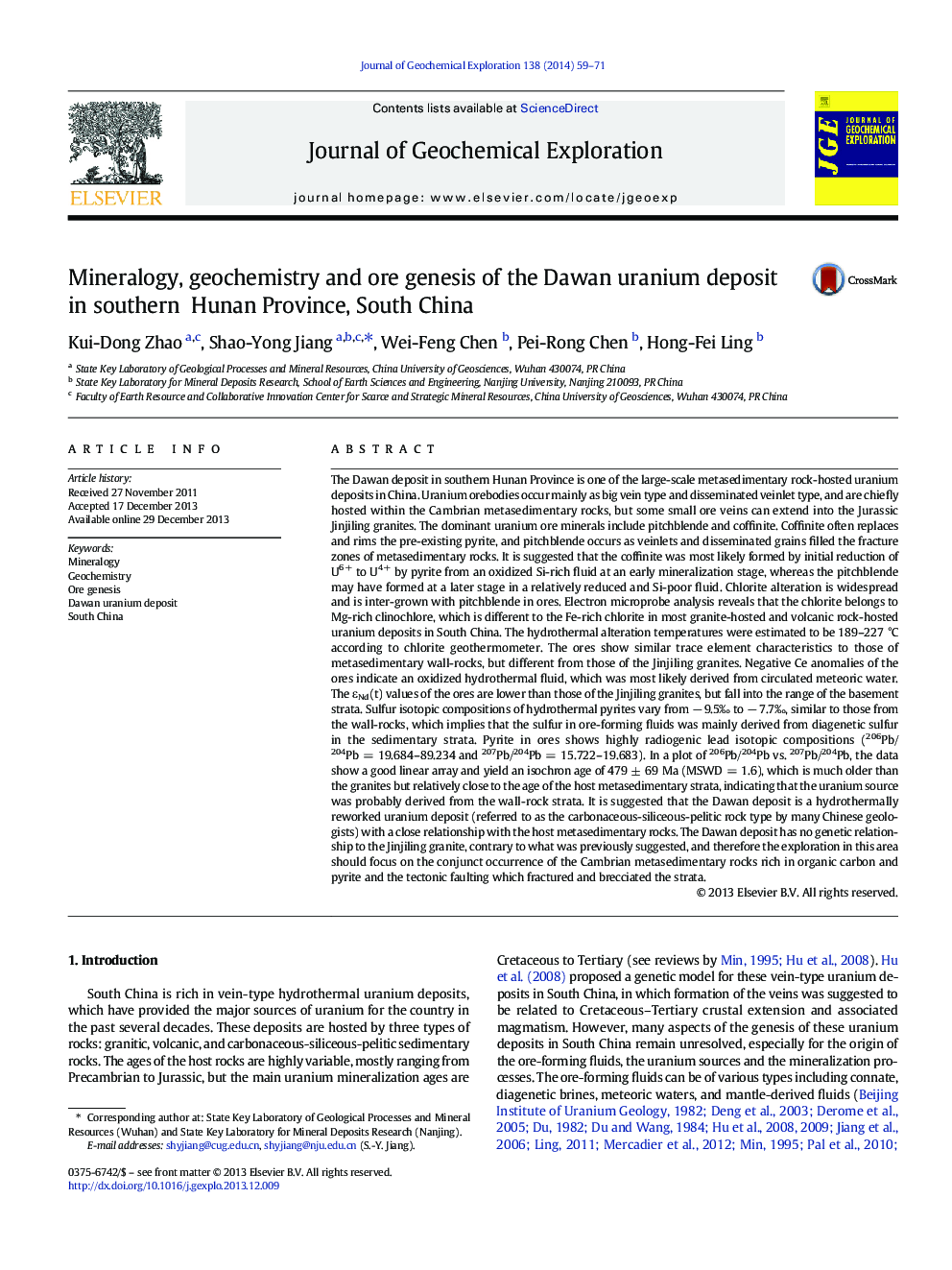| کد مقاله | کد نشریه | سال انتشار | مقاله انگلیسی | نسخه تمام متن |
|---|---|---|---|---|
| 4457449 | 1620919 | 2014 | 13 صفحه PDF | دانلود رایگان |
• The Dawan deposit is a hydrothermal-reworked sedimentary hosted uranium deposit.
• Sulfur in ore-forming fluids was derived from diagenetic sulfur in the host strata.
• Uranium in ores was derived from the U-rich meta-sedimentary strata.
• Ore-forming fluid was derived from deeply circulated, oxidized, meteoric water.
• Exploration should focus on organic- and pyrite-rich sedimentary strata with faults.
The Dawan deposit in southern Hunan Province is one of the large-scale metasedimentary rock-hosted uranium deposits in China. Uranium orebodies occur mainly as big vein type and disseminated veinlet type, and are chiefly hosted within the Cambrian metasedimentary rocks, but some small ore veins can extend into the Jurassic Jinjiling granites. The dominant uranium ore minerals include pitchblende and coffinite. Coffinite often replaces and rims the pre-existing pyrite, and pitchblende occurs as veinlets and disseminated grains filled the fracture zones of metasedimentary rocks. It is suggested that the coffinite was most likely formed by initial reduction of U6 + to U4 + by pyrite from an oxidized Si-rich fluid at an early mineralization stage, whereas the pitchblende may have formed at a later stage in a relatively reduced and Si-poor fluid. Chlorite alteration is widespread and is inter-grown with pitchblende in ores. Electron microprobe analysis reveals that the chlorite belongs to Mg-rich clinochlore, which is different to the Fe-rich chlorite in most granite-hosted and volcanic rock-hosted uranium deposits in South China. The hydrothermal alteration temperatures were estimated to be 189–227 °C according to chlorite geothermometer. The ores show similar trace element characteristics to those of metasedimentary wall-rocks, but different from those of the Jinjiling granites. Negative Ce anomalies of the ores indicate an oxidized hydrothermal fluid, which was most likely derived from circulated meteoric water. The εNd(t) values of the ores are lower than those of the Jinjiling granites, but fall into the range of the basement strata. Sulfur isotopic compositions of hydrothermal pyrites vary from − 9.5‰ to − 7.7‰, similar to those from the wall-rocks, which implies that the sulfur in ore-forming fluids was mainly derived from diagenetic sulfur in the sedimentary strata. Pyrite in ores shows highly radiogenic lead isotopic compositions (206Pb/204Pb = 19.684–89.234 and 207Pb/204Pb = 15.722–19.683). In a plot of 206Pb/204Pb vs. 207Pb/204Pb, the data show a good linear array and yield an isochron age of 479 ± 69 Ma (MSWD = 1.6), which is much older than the granites but relatively close to the age of the host metasedimentary strata, indicating that the uranium source was probably derived from the wall-rock strata. It is suggested that the Dawan deposit is a hydrothermally reworked uranium deposit (referred to as the carbonaceous-siliceous-pelitic rock type by many Chinese geologists) with a close relationship with the host metasedimentary rocks. The Dawan deposit has no genetic relationship to the Jinjiling granite, contrary to what was previously suggested, and therefore the exploration in this area should focus on the conjunct occurrence of the Cambrian metasedimentary rocks rich in organic carbon and pyrite and the tectonic faulting which fractured and brecciated the strata.
Journal: Journal of Geochemical Exploration - Volume 138, March 2014, Pages 59–71
